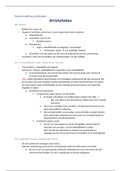Samenvatting
Summary Lecture Notes Quantative Modelling test 2
- Instelling
- Universiteit Twente (UT)
Lecture notes of the Quantative Modeling lectures given by Ipek Seyran Topan in BOM (module 2 of IBA at the UT). Includes all the useful formulas and explanations relevant for test 2. Covers lectures 7,8,9,10,11,12
[Meer zien]













